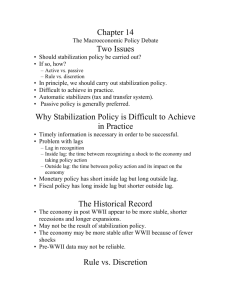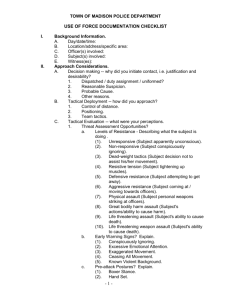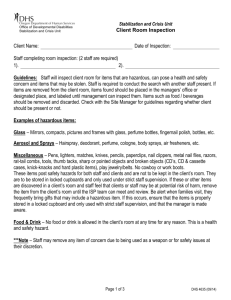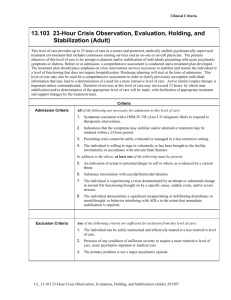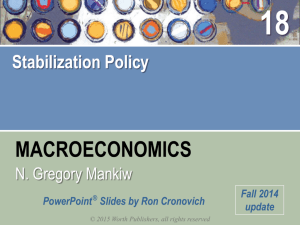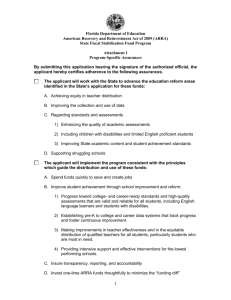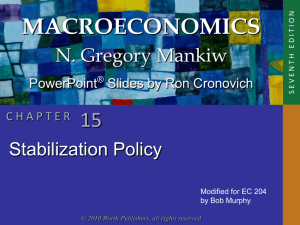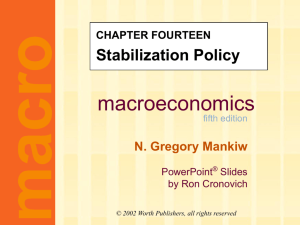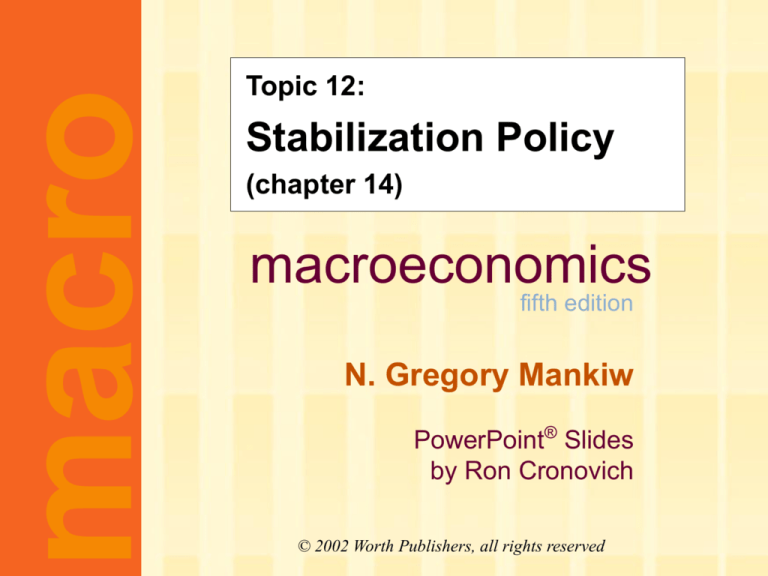
macro
Topic 12:
Stabilization Policy
(chapter 14)
macroeconomics
fifth edition
N. Gregory Mankiw
PowerPoint® Slides
by Ron Cronovich
© 2002 Worth Publishers, all rights reserved
Question 1:
Should policy be
______ or _____?
CHAPTER 14
Stabilization Policy
slide 1
Arguments for active policy
Recessions cause economic hardship for
millions of people.
The Employment Act of 1946:
“it is the continuing policy and responsibility
of the Federal Government to…promote full
employment and production.”
The model of aggregate demand and supply
(Chapters 9-13) shows how fiscal and
monetary policy can respond to shocks and
stabilize the economy.
CHAPTER 14
Stabilization Policy
slide 2
Arguments against active policy
1. ________________
__________:
the time between the shock and the policy response
takes time to recognize shock
takes time to implement policy,
especially fiscal policy
__________:
the time it takes for policy to affect economy
If conditions change before policy’s impact is felt,
then policy may end up destabilizing the economy.
CHAPTER 14
Stabilization Policy
slide 3
Forecasting the macroeconomy
Because policies act with lags, __________
________________________________.
Ways to generate forecasts:
• ___________________:
data series that fluctuate in advance of the
economy
• Macroeconometric ______:
Large-scale models with estimated
parameters that can be used to forecast the
response of endogenous variables to shocks
and policies
CHAPTER 14
Stabilization Policy
slide 5
Mistakes Forecasting the Recession of 1982
Unemployment 11.0
rate (percent)
10.5
10.0
1982:4
9.5
9.0
1982:2
1983:2
8.5
1981:4
8.0
1983:4
7.5
1981:2
7.0
Actual
6.5
6.0
1980
CHAPTER 14
1981
1982
1983
Stabilization Policy
1984
1985
1986
Year
slide 6
Forecasting the macroeconomy
Because policies act with lags, policymakers
must predict future conditions.
The preceding slides show that the
forecasts are often wrong.
This is one reason why some
economists oppose policy activism.
CHAPTER 14
Stabilization Policy
slide 7
The Lucas Critique
Due to Robert Lucas
won Nobel Prize in 1995 for “rational
expectations”
Forecasting the effects of policy changes has
often been done using models estimated with
historical data.
Lucas pointed out that such predictions would
not be valid if the policy change ________
___________________________________
___________________________________.
CHAPTER 14
Stabilization Policy
slide 8
An example of the Lucas Critique
Prediction (based on past experience):
an increase in the money growth rate will
reduce unemployment
The Lucas Critique points out that increasing
the money growth rate may raise expected
inflation, _____________________________
___________________________________.
CHAPTER 14
Stabilization Policy
slide 9
The Jury’s Out…
Looking at recent history does not clearly
answer Question 1:
• It’s hard to identify shocks in the data,
• and it’s hard to tell how things would have
been different had actual policies not been
used.
CHAPTER 14
Stabilization Policy
slide 10
Question 2:
Should policy
be conducted by
____ or _______?
CHAPTER 14
Stabilization Policy
slide 11
Rules and Discretion: basic concepts
Policy conducted by rule:
Policymakers announce in advance how
policy will respond in various situations, and
commit themselves to following through.
Policy conducted by discretion:
As events occur and circumstances change,
policymakers use their judgment and apply
whatever policies seem appropriate at the
time.
CHAPTER 14
Stabilization Policy
slide 12
Arguments for Rules
1. _________________________________
_________________________________
misinformed politicians
politicians’ interests sometimes not the
same as the interests of society
CHAPTER 14
Stabilization Policy
slide 13
Arguments for Rules
2. The Time Inconsistency of
Discretionary Policy
def: __________________________
______________________________
______________________________.
Destroys policymakers’ credibility, thereby
reducing effectiveness of their policies.
CHAPTER 14
Stabilization Policy
slide 14
Examples of Time-Inconsistent Policies
To encourage investment,
government announces it
won’t tax income from capital.
But once the factories are built,
the govt reneges in order to
raise more tax revenue.
CHAPTER 14
Stabilization Policy
slide 15
Monetary Policy Rules
a.
b.
c.
d.
Target Federal Funds rate based on
inflation rate
gap between actual & full-employment
GDP
CHAPTER 14
Stabilization Policy
slide 16
The Taylor Rule
i ff + 2 + 0.5( 2) 0.5(GDP Gap)
where:
i ff = nominal federal funds rate
Y Y
GDP Gap = 100
Y
= the percent by which real GDP
is below its natural rate
CHAPTER 14
Stabilization Policy
slide 17
The Taylor Rule
i ff + 2 + 0.5( 2) 0.5(GDP Gap)
If = 2 and output is at its natural rate,
then monetary policy targets the nominal Fed
Funds rate at 4%.
For each one-point increase in ,
mon. policy is automatically tightened to ___
_________________________________.
For each one percentage point that GDP falls
below its natural rate, mon. policy automatically
_________________________________.
CHAPTER 14
Stabilization Policy
slide 18
Does Greenspan follow the Taylor Rule?
The Federal Funds Rate
Actual and Suggested
12
Actual
Taylor's rule
Percent
10
8
6
4
2
0
1987
CHAPTER 14
1990
1993
Stabilization Policy
1996
1999
2002
slide 19
Central Bank Independence
A policy rule announced by Central Bank
will work only if _____________________
____________________________.
Credibility depends in part on degree of
independence of central bank.
CHAPTER 14
Stabilization Policy
slide 20
Inflation and Central Bank Independence
Average
Average
inflation9
in½ation
Spain
8
New Zealand
7
Italy
United Kingdom
Denmark
Australia
France/Norway/Sweden
6
5
Japan
Canada
Netherlands
Belgium
4
Switzerland
Germany
3
2
0.5
United States
1
CHAPTER 14
1.5
2
2.5
Stabilization Policy
3
3.5
4
4.5
Index
central-bank
independence
Index
ofofcentral
bank independence
slide 21
Chapter summary
1. Advocates of active policy believe:
frequent shocks lead to unnecessary
fluctuations in output and employment
fiscal and monetary policy can stabilize the
economy
2. Advocates of passive policy believe:
the long & variable lags associated with
monetary and fiscal policy render them
ineffective and possibly destabilizing
inept policy increases volatility in output,
employment
CHAPTER 14
Stabilization Policy
slide 22
Chapter summary
3. Advocates of discretionary policy believe:
discretion gives more flexibility to
policymakers in responding to the
unexpected
4. Advocates of policy rules believe:
the political process cannot be trusted:
politicians make policy mistakes or use
policy for their own interests
commitment to a fixed policy is necessary
to avoid time inconsistency and maintain
credibility
CHAPTER 14
Stabilization Policy
slide 23




